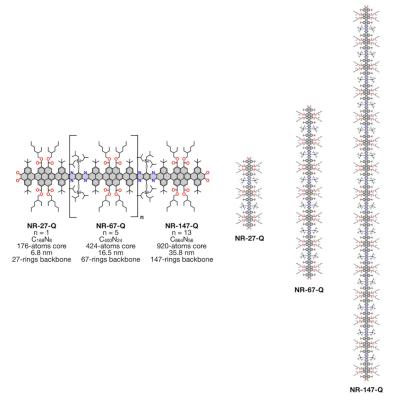Researchers from POLYMAT at the University of the Basque Country UPV/EHU, Max Planck Institute for Polymer Research and the University of Aveiro have reported an accelerated iterative approach enabling the synthesis of a series of length-controlled, ultralong atomically precise graphene nanoribbons (GNRs). The longest GNR displays a 920-atoms core with a 35.8-nm long (147 linearly fused rings) backbone that has been obtained in just three synthetic steps from building blocks of ∼2 nm in length.
A Lego-like synthesis previously produced record-breaking nanoribbons of 30, then 53 fused rings. Now, a similar ‘accelerated’ modular methodology made a molecular nanoribbon that is triple the longest ever made – in just three simple steps. The resulting graphene nanoribbon is almost 36nm long, with its 147 linearly linked rings and a conjugated core of 920 atoms. The first experiments, although preliminary, envision applications in electronics and optoelectronics, thanks to fluorescence features that reportedly outperform state-of-the-art quantum dots.
The team developed a straightforward synthesis approach from smaller nanoribbons, which outperforms existing solutions in both length and precision. Different small structures just 2nm long constitute the basic building blocks, the Lego pieces – each of them has complementary terminations, with either carbonyl or amine groups. The appropriate acidic conditions trigger the click-like condensation reactions to join them together. Each iteration forms an exponentially longer nanoribbon, eventually forming the record-breaking 36nm structure.
The small sequence of steps avoids excess separations and purifications – usually a drawback of making macromolecules incrementally. The 147-ring nanoribbon is surprisingly soluble, thanks to a twisted backbone, and a substantial supply of side chains with bulky alkyl and silyl functional groups. This allows researchers to use standard synthetic chemistry techniques to purify and characterize the structure.
The nanoribbons’ solubility also simplified the study of structural, electronic and optoelectronic properties. The team notes that its nanoribbons break records in terms of fluorescence, with absorption and emission values that surpass carbon quantum dots, and competes head-to-head with the best inorganic quantum dots. This could open the door to applications in LEDs, photovoltaics, imaging and much more. Moreover, the length of the nanoribbon enabled measurements of conductivity and carrier mobility with terahertz spectroscopy, a technique that’s ineffective in smaller structures. The results, supported by DFT simulations, reveal relatively high charge mobility values, which could convey new uses in electronics.
The researchers also observed a correlation between the length of graphene nanoribbons and properties like light absorption, fluorescence and conductivity. This unprecedented understanding opens opportunities in terms of the tailored design of ultralong nanoribbons for specific applications.
